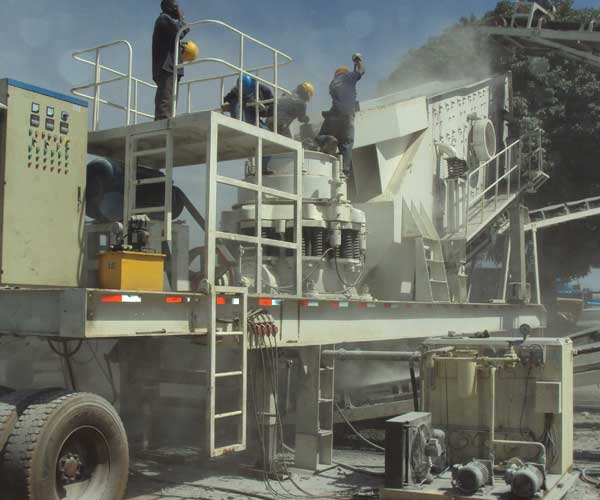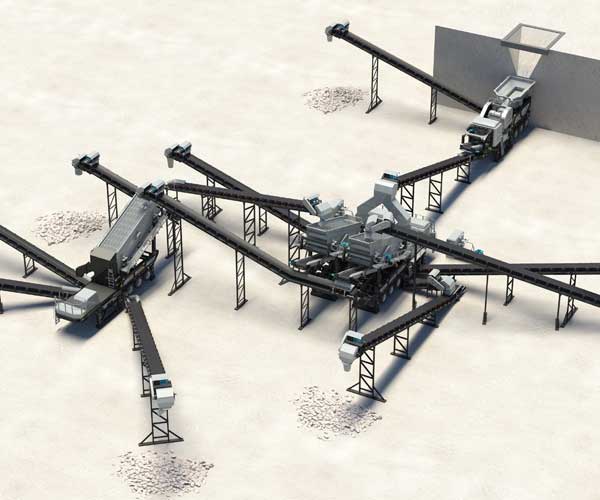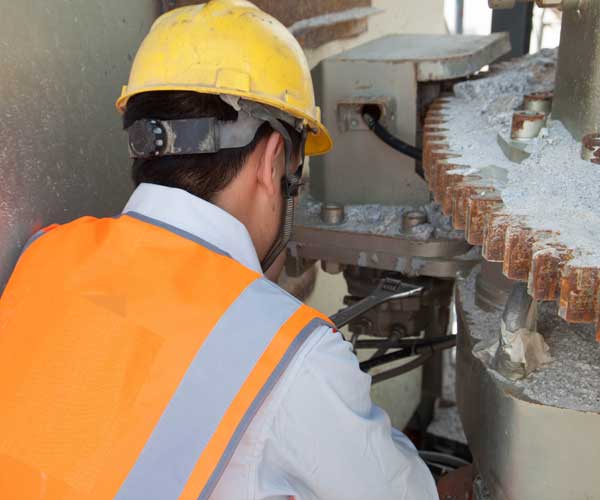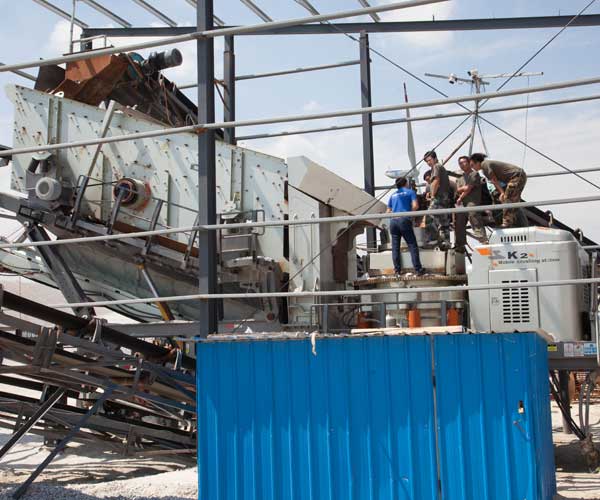
Portable crushers are indispensable tools for various industries, enabling efficient on-site crushing and reducing overall project costs. To ensure their longevity and optimal performance, operators must implement proactive maintenance procedures, such as regular inspections, lubrication, and filter replacements.
24 Online Service

Enter the portable crusher, a technological marvel that has revolutionized material processing on job sites. A portable crusher, also known as a mobile crusher, is a compact and self-contained unit designed to break down various types of materials into smaller, more manageable sizes. This cutting-edge equipment has become an indispensable asset, offering an array of benefits over traditional stationary crushers.
The chassis serves as the foundation upon which all other components of a portable crusher are integrated. Typically made from robust steel, the chassis provides structural support and stability during operation. Mounted on the chassis, the undercarriage comprises a set of heavy-duty tracks or wheels, depending on the model. These tracks/wheels enable the crusher to traverse challenging terrains, providing the much-needed mobility to access remote job sites or navigate uneven ground.
At the heart of any portable crusher is the feeder unit, which is responsible for regulating a consistent flow of raw materials into the crusher chamber. The feeder may use various mechanisms such as a vibrating grizzly, apron feeder, or pan feeder to convey the material onto the crushing equipment. An efficient and reliable feeder ensures a steady supply of material, optimizing the crusher’s productivity and preventing jams or overloading.
The crushing chamber is the core component responsible for breaking down the raw material into smaller, uniform-sized particles. Within the chamber, a variety of crushing mechanisms can be employed, including jaw crushers, impact crushers, cone crushers, or gyratory crushers. Each type of crusher operates differently, offering distinct advantages depending on the application.
Jaw Crushers: Utilize a fixed jaw and a moving jaw to apply compressive force on the material, breaking it down into smaller pieces.
Impact Crushers: Employ hammers or blow bars that strike the material, imparting high-speed impact forces to shatter it.
Cone Crushers: Feature a cone-shaped crushing head that gyrates inside a concave bowl, squeezing the material until it breaks apart.
Gyratory Crushers: Have a conical head gyrating within an outer concave shell, resulting in a more consistent and controlled process.
The selection of the appropriate crushing chamber and crusher type depends on factors such as the material’s hardness, abrasiveness, and desired final product size.
After the raw material is processed by the crusher, the next challenge is efficiently transporting the final product away from the crushing chamber and onto trucks or stockpiles. This task is accomplished by a well-designed conveyor system. Conveyors in portable crushers can vary in length and configuration but typically consist of a series of belts or chains that transfer the crushed material to the desired location. Advanced conveyor systems come equipped with self-cleaning magnets to remove metal contaminants and ensure the purity of the final product.
To unleash the crushing power on the move, a portable crusher relies on a reliable and potent power source. Diesel engines and electric motors are the two main options commonly used in portable crushers. Diesel engines offer the advantage of being self-contained, making them suitable for off-grid locations. Electric motors, on the other hand, are quieter, emit fewer emissions, and can be connected to the grid or use onboard generators for power. The choice between diesel and electric power depends on factors like operating costs, environmental concerns, and the availability of power infrastructure.
In the digital age, automation and control systems play a pivotal role in optimizing crusher performance and enhancing operator safety. The control panel serves as the nerve center, allowing operators to start, stop, and adjust the crusher’s operation. Advanced monitoring systems provide real-time data on crucial parameters such as crusher throughput, material levels, and power consumption. These insights empower operators to make informed decisions, ensure maximum efficiency, and prevent potential equipment failures.
The crushing process can generate considerable dust, which poses health hazards to workers and affects the environment. As a result, modern portable crushers are equipped with dust suppression systems. These systems use water or chemical agents to suppress airborne particles, minimizing the risk of respiratory issues for operators and keeping surrounding areas clean.

Portable crushers have become an essential tool in various industries, including mining, construction, and recycling. These versatile machines offer mobility and flexibility, enabling operators to process materials on-site efficiently. However, like any other equipment, portable crushers require regular maintenance to ensure their longevity, reliability, and optimal performance. Neglecting proper maintenance can lead to breakdowns, reduced productivity, and increased operational costs.
Before operating and maintaining a portable crusher, it is crucial to thoroughly read and understand the manufacturer’s manual. The manual provides vital information about the machine’s specifications, safety guidelines, recommended maintenance schedules, and troubleshooting procedures. Familiarizing yourself with this document will help you make informed decisions during maintenance and avoid potential issues caused by improper usage.
Perform regular inspections of the portable crusher to identify any visible signs of wear, damage, or potential problems. Look for loose bolts, worn-out components, and leaking fluids. Pay close attention to belts, hoses, and electrical connections. Addressing minor issues promptly can prevent them from escalating into more significant problems that may disrupt operations.
Proper lubrication is essential for the smooth functioning of a portable crusher. Refer to the manufacturer’s guidelines to determine the appropriate lubricants and intervals for each part of the machine. Bearings, gears, and other moving components should receive adequate lubrication to reduce friction and prevent premature wear. Regularly inspect the lubrication system and replace lubricants as needed.
Air, fuel, and hydraulic filters play a critical role in keeping the crusher’s engine and hydraulic systems clean and efficient. Clogged or dirty filters can reduce performance and increase fuel consumption. Follow the recommended filter replacement schedule to ensure the crusher operates at its best.
Electrical systems are susceptible to damage due to dust, moisture, and vibrations. Routinely inspect wiring, connectors, and switches to ensure they are intact and functioning correctly. Make sure that the battery is in good condition and that all electrical connections are secure.
Maintaining the proper levels of engine oil, hydraulic fluid, and coolant is crucial for the crusher’s performance and longevity. Regularly check fluid levels and top them up as necessary. Be attentive to any signs of leaks, which may indicate a problem that needs immediate attention.
Dust, dirt, and debris can accumulate on a portable crusher during operation. Regularly clean the machine to prevent these particles from entering critical components and causing damage. Use appropriate cleaning methods and avoid using high-pressure water jets, as they can force contaminants into sensitive areas.
Unusual noises coming from the crusher can indicate underlying issues that require attention. Grinding, squealing, or knocking sounds may suggest problems with bearings, belts, or other mechanical components. Investigate and resolve these issues promptly to prevent further damage.
Proper operation and maintenance of portable crushers depend on well-trained operators. Provide comprehensive training to your team to ensure they understand the machine’s functions, safety protocols, and maintenance procedures. Knowledgeable operators can detect problems early and operate the equipment efficiently, extending its lifespan.
Develop a comprehensive scheduled maintenance plan based on the manufacturer’s recommendations and the crusher’s specific needs. Create a checklist of maintenance tasks and adhere to a regular schedule. A well-structured maintenance plan ensures that no essential maintenance tasks are overlooked and helps keep the crusher in peak condition.

Portable crushers have revolutionized the mining and construction industries by providing on-site crushing capabilities, enhancing project efficiency, and reducing transportation costs. These versatile machines are designed to crush various materials, such as rocks, minerals, concrete, and asphalt, into smaller, more manageable sizes. However, like any complex equipment, portable crushers require regular maintenance to ensure optimal performance and prevent costly breakdowns.
The adage “prevention is better than cure” holds true when it comes to portable crusher maintenance. A proactive approach to maintenance not only extends the lifespan of the equipment but also reduces the likelihood of unexpected breakdowns that can halt production and lead to substantial financial losses. By implementing regular maintenance procedures, operators can detect potential issues early, address them promptly, and maintain peak operational efficiency.
Regular inspections are the backbone of preventive maintenance. Before and after each use, operators should thoroughly inspect the portable crusher, checking for loose or worn parts, leaking hydraulic lines, and excessive vibrations. In addition, it’s vital to ensure all critical components are adequately lubricated. Lubrication prevents friction-related wear and ensures smooth operation.
Air, oil, and hydraulic filters play a crucial role in maintaining the cleanliness of the crusher’s systems. Regularly replacing these filters prevents contaminants from entering sensitive components, such as the engine, hydraulic system, and bearings, safeguarding against premature wear and potential breakdowns.
Portable crushers are equipped with wear parts such as jaw plates, cone liners, and hammers, which undergo significant stress during the crushing process. Regularly inspecting and replacing these parts when they reach their wear limits is essential to maintain crushing efficiency and avoid costly damages to the crusher itself.
The conveyor system is a vital part of any portable crusher, responsible for transporting material to and from the crusher unit. Regularly inspecting the belts for wear and damage and ensuring proper tension is crucial to avoid unexpected stoppages and keep material flow consistent.
The electrical components of a portable crusher, including motors, starters, and wiring, require regular inspection and maintenance. Any signs of overheating, damaged wires, or loose connections should be addressed promptly to avoid electrical failures that could lead to safety hazards or operational downtime.
When a problem arises, it’s essential to identify its root cause before attempting any repairs. Proper diagnostics by qualified technicians can pinpoint the specific area of concern and help avoid unnecessary repairs.
Using authorized and genuine parts during repairs ensures compatibility and quality, maintaining the integrity of the portable crusher. Collaborate with reputable suppliers to source the necessary replacement parts.
Safety should always be a top priority during repair processes. Before beginning any repair work, operators and technicians must follow safety protocols, including locking out and tagging out power sources to prevent accidents.
Only trained personnel with relevant expertise should handle complex repairs. Specialized training equips technicians to understand the equipment thoroughly, diagnose issues accurately, and perform repairs effectively.
Maintain detailed records of all maintenance activities and repairs. This documentation provides a historical perspective on the equipment’s performance, helps track recurring issues, and aids in making informed decisions about future maintenance plans.
Our Projects
Copyright © ZENITH, All Right Reserved.
